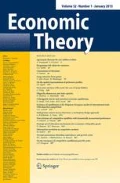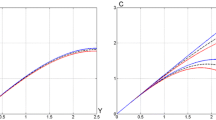But this long run is a misleading guide to current affairs. In the long run we are all dead. Economists set themselves too easy, too useless a task if in tempestuous seasons they can only tell us that when the storm is long past the ocean is flat again.
Keynes (1923)
Abstract
This paper investigates the well-known phenomenon of eventual periodicity of Li–Yorke chaos in the context of the two-sector Robinson–Shinkai–Leontief model of economic growth. It locates its (i) presence under specific parameter restrictions that include the extreme classical saving specification, and its (ii) absence in savings generated by the optimization of an infinitely-lived representative agent with perfect foresight. These results in which rare events, chaos and stability are all brought together under the rubric of upward and downward inertia, while of substantive economic interest of their own, also highlight phenomena in economic dynamics that may go towards a clearer definitional understanding of chaotic systems.
Similar content being viewed by others
Availability of data and materials (data transparency)
Not applicable.
Code availability
Not applicable.
References
Amano, A.: A further note on Professor Uzawa’s two-sector model of economic growth. Rev. Econ. Stud. 31, 97–102 (1964)
Atkinson, A.: The timescale of economic models: how long is the long run? Rev. Econ. Stud. 36(2), 137–152 (1969)
Benhabib, J., Day, R.: A characterization of erratic dynamics in the overlapping generation model. J. Econ. Dyn. Control 4, 37–55 (1982)
Burmeister, E., Dobell, A.R.: Mathematical Theories of Economic Growth. MacMillan, New York (1970)
Carter, Z.D.: The Price of Peace: Money, Democracy and the Life of John Mynard Keynes. Random House, London (2020)
Corden, W.M.: The two sector growth model with fixed coefficients. Rev. Econ. Stud. 33, 253–262 (1966)
Day, R., Shaffer, W.: Keynesian chaos. J. Macroecon. 7, 277–295 (1985)
Deng, L., Fujio, M., Khan, M.A.: Optimal growth in the Robinson–Shinkai–Leontief model: the case of capital-intensive consumption goods. Stud. Nonlinear Dyn. Econom. 23(4), 20190032 (2019)
Dixit, A.: Growth patterns in a dual economy. Oxf. Econ. Pap. 22(2), 229–234 (1970)
Dixit, A.K.: The Theory of Equilibrium Growth. Oxford University Press, Oxford (1976)
Fujio, M.: The Leontief two-sector model and undiscounted optimal growth with irreversible investment: the case of labor-intensive consumption goods. J. Econ. 86(2), 145–159 (2005)
Fujio, M.: Optimal transition dynamics in the Leontief two-sector growth model. PhD thesis, The Johns Hopkins University (2006)
Fujio, M.: Undiscounted optimal growth in a Leontief two-sector model with circulating capital: the case of a capital-intensive consumption good. J. Econ. Behav. Organ. 66(2), 420–436 (2008)
Fujio, M.: Optimal transition dynamics in the Leontief two-sector growth model with durable capital: the case of capital-intensive consumption goods. Jpn. Econ. Rev. 60(4), 490–511 (2009)
Fujio, M., Khan, M.A.: Ronald W. Jones and two-sector growth: Ramsey optimality in the RSS and Leontief cases. Asia-Pac. J. Account. Econ. 13(2), 87–110 (2006)
Hahn, F.H., Matthews, R.C.O.: The theory of economic growth: a survey. Econ. J. 74(296), 779–902 (1964)
Hammond, P.J., Rodriguez-Clare, A.: On endogenizing long-run growth. Scand. J. Econ. 95(4), 391–425 (1993)
Inada, K.I.: On a two-sector model of economic growth: comments and a generalization. Rev. Econ. Stud. 30, 119–127 (1963)
Inada, K.I.: On the stability of growth equilibrium in two-sector models. Rev. Econ. Stud. 31, 127–142 (1964)
Keynes, J.M.: A Tract on Monetary Reform. Macmillan, London (1923)
Khan, M.A., Mitra, T.: On choice of technique in the Robinson–Solow–Srinivasan model. Int. J. Econ. Theory 1(2), 83–110 (2005)
Khan, M.A., Mitra, T.: Undiscounted optimal growth in the two-sector Robinson–Solow–Srinivasan model: a synthesis of the value-loss approach and dynamic programming. Econ. Theor. 29(2), 341–362 (2006)
Khan, M.A., Mitra, T.: Impatience and dynamic optimal behavior: a bifurcation analysis of the Robinson–Solow–Srinivasan model. Nonlinear Anal. Theory Methods Appl. 75(3), 1400–1418 (2012)
Khan, M.A., Piazza, A.: Optimal cyclicity and chaos in the 2-sector RSS model: an anything-goes construction. J. Econ. Behav. Organ. 80(3), 397–417 (2011)
Khan, M.A., Rajan, A.V.: On the eventual periodicity of piecewise linear chaotic maps. Bulletin of the Australian Mathematical Society 95(3), 467–475 (2017)
Li, T.Y., Yorke, J.A.: Period three implies chaos. Am. Math. Mon. 82(10), 985–992 (1975)
Mann, G.: In the Long Run We Are All Dead: Keynesianism, Political Economy and Revolution. Verso, London (2017)
Matsuyama, K.: Growing through cycles. Econometrica 67(2), 335–347 (1999)
Mitra, T., Nishimura, K., Sorger, G.: Optimal cycles and chaos. In: Dana, R.A., Le Van, C., Mitra, T., Nishimura, K. (eds.) Handbook of Optimal Growth, Chap. 6, vol. 1, pp. 141–169. Springer, Berlin (2006)
Nathanson, M.B.: Permutations, periodicity, and chaos. J. Combin. Theory Ser. A 22(1), 61–68 (1977)
Nishimura, K., Yano, M.: Optimal chaos, nonlinearity and feasibility conditions. Econ. Theor. 4(5), 689–704 (1994)
Nishimura, K., Yano, M.: Nonlinear dynamics and chaos in optimal growth: an example. Econometrica 63(4), 981–1001 (1995)
Nishimura, K., Yano, M.: Chaotic solutions in dynamic linear programming. Chaos Solitons Fractals 7(11), 1941–1953 (1996)
Ormerod, P., Rosewell, B.: Validation and verification of agent-based models in the social sciences. In: Squazzoni, F. (ed.) Epistemological Aspects of Computer Simulation, pp. 130–140. Springer, Berlin (2006)
Ruette, S.: Chaos on the Interval. Volume 67 of University Lecture Series, American Mathematical Society (2017)
Shinkai, Y.: On equilibrium growth of capital and labor. Int. Econ. Rev. 1(2), 107 (1960)
Sorger, G.: On the structure of Ramsey equilibrium: cycles, indeterminacy, and sunspots. Econ. Theor. 4(5), 745–764 (1994)
Steedman, I.: Growth and distribution: a muddling exercise. Camb. J. Econ. 14(2), 229–232 (1990)
Takayama, A.: On a two-sector model of economic growth: a comparative statics analysis. Rev. Econ. Stud. 30, 95–104 (1963)
Tobin, J.: Growth and distribution: a neoclassical Kaldor–Robinson exercise. Camb. J. Econ. 13(1), 37–45 (1989)
Turnovsky, S.: Old and new growth theories: a unifying structure? In: Salvadori, N. (ed.) Old and New Growth Theories: an Assessment, pp. 1–44. Edward Elgar, Cheltenham (2003)
Uzawa, H.: On a two-sector model of economic growth. Rev. Econ. Stud. 29, 40–47 (1961)
Uzawa, H.: On a two-sector model of economic growth II. Rev. Econ. Stud. 30, 105–118 (1963)
Author information
Authors and Affiliations
Corresponding author
Ethics declarations
Conflict of interest
The authors declare that they have no conflict of interest.
Additional information
Publisher's Note
Springer Nature remains neutral with regard to jurisdictional claims in published maps and institutional affiliations.
This paper is dedicated to the memory of T. N. Srinivasan, a pioneer of two-sector growth theory, a past editor of Econometrica, and also a mentor and role-model to so many others going well beyond the authors of this modest contribution, modest especially when keeping TN’s high standards in mind. Part of the results reported in this essay were presented at the 26th Annual Symposium of the Society for Nonlinear Dynamics and Econometrics in Keio University on March 19, 2018. The authors gratefully acknowledge stimulating conversation and exchanges with Bob Barbera, Jess Benhabib, Chris Carroll, Edmund Crawley, Tapan Mitra, Kazuo Nishimura, and Kevin Reffett, and finally, the encouragement of the Associate Editor of this journal and the careful reading of his/her two anonymous referees. Liuchun Deng acknowledges the support of the Start-up Grant from Yale-NUS College.
Rights and permissions
About this article
Cite this article
Deng, L., Fujio, M. & Khan, M.A. Eventual periodicity in the two-sector RSL model: equilibrium vis-à-vis optimum growth. Econ Theory 72, 615–639 (2021). https://doi.org/10.1007/s00199-020-01301-0
Received:
Accepted:
Published:
Issue Date:
DOI: https://doi.org/10.1007/s00199-020-01301-0




